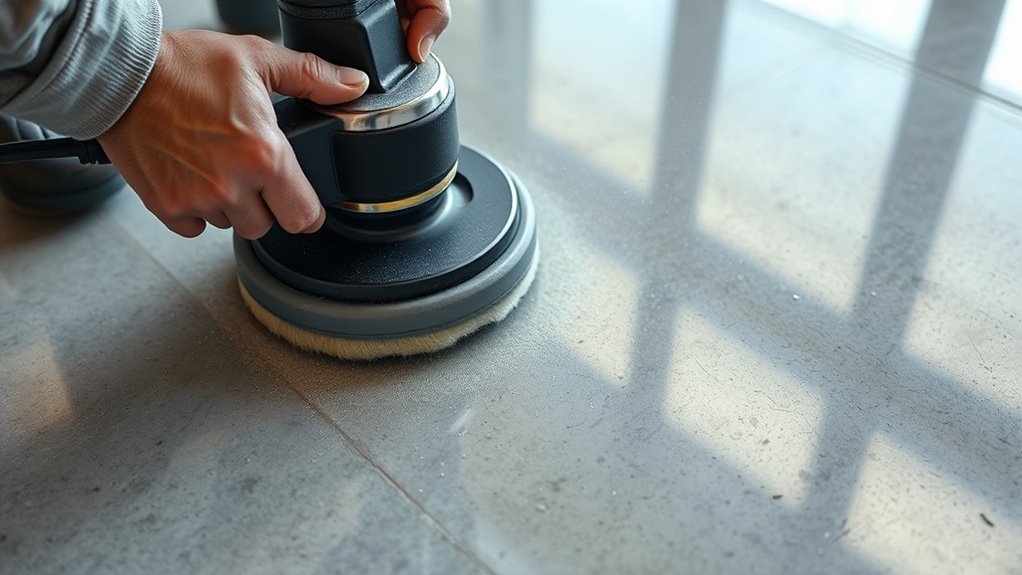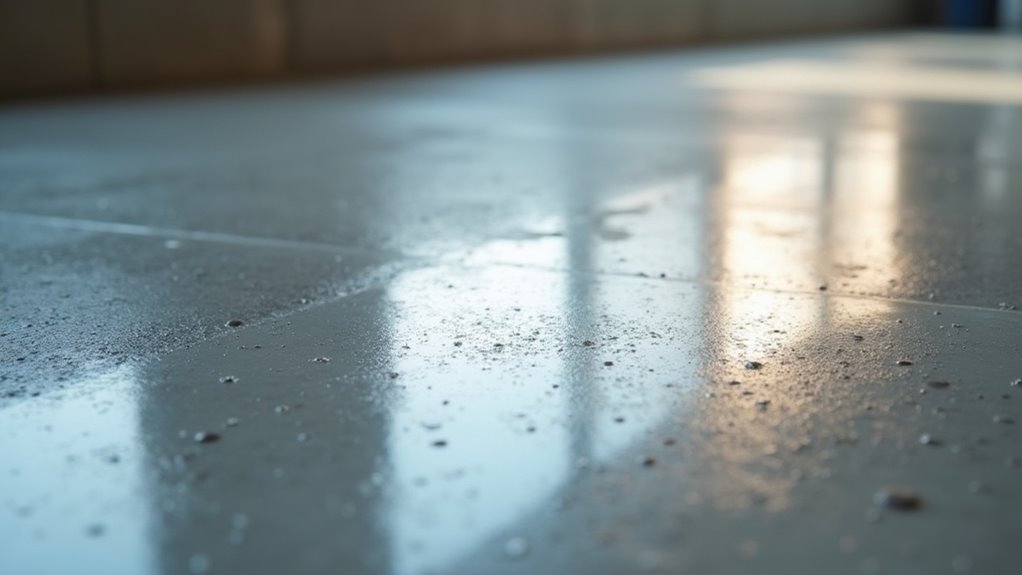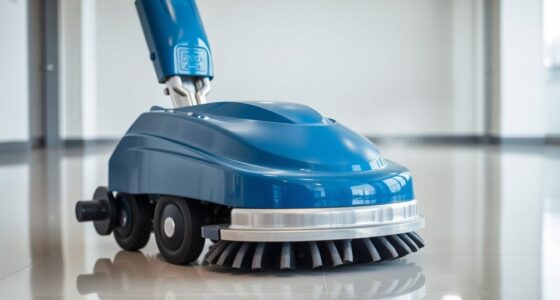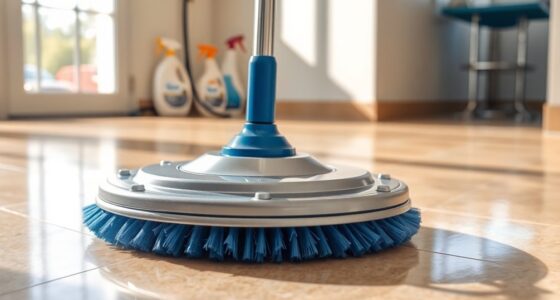When polishing concrete, applying too much down pressure can cause surface damage, unevenness, or over-penetration of abrasives. Use enough force to let the machine’s weight and abrasive grit do most of the work, usually gentle and controlled pressure is best. Coarser grits demand more force, but avoid excessive pressure that can harm the surface or your equipment. For tips on achieving the perfect balance, keep exploring ways to improve your polishing technique.
Key Takeaways
- Use controlled, steady downward force; excessive pressure can cause surface damage and uneven polishing.
- Match down pressure to abrasive grit: lighter for finer grits, moderate for coarser grits.
- Rely on machine weight; avoid applying extra force beyond the equipment’s natural pressure.
- Monitor for deep scratches or surface inconsistencies indicating too much pressure.
- Adjust pressure throughout the process to prevent over-penetration and maintain surface quality.

Applying the right down pressure during polished concrete processes is essential for achieving a smooth, durable finish. When you’re working with abrasive grit and heavy machinery, knowing how much pressure to apply can make all the difference. Too little pressure, and the surface may remain dull or uneven; too much, and you risk damaging the concrete or causing unwanted surface defects. Striking the right balance ensures that the abrasive grit wears evenly and that the machine weight used during grinding or polishing results in a consistent, professional finish.
Your choice of abrasive grit plays a crucial role here. Finer grits require less pressure because they’re designed to smooth and refine the surface gently. Coarser grits, on the other hand, are more aggressive and may need more downward force to remove roughness or imperfections. However, applying excessive pressure with coarse grit can lead to over-penetration, creating uneven patches or gouges. It’s important to adjust the pressure according to the grit you’re using, making sure you don’t push too hard, especially with finer abrasives that need a lighter touch to achieve a high-polish effect.
Finer grits need less pressure; coarser grits require more, but avoid over-penetration and surface damage.
The machine weight is another key factor in controlling down pressure. Heavy-duty grinding and polishing machines exert more force naturally, so you don’t need to add much extra pressure. If you’re using a machine with a high weight, you should focus on applying consistent, gentle pressure rather than pressing down hard. Overloading a heavy machine with additional force can cause rapid wear of the abrasive tools and increase the risk of damaging the concrete surface. Conversely, lighter machines may require you to apply more deliberate downward force to achieve effective grinding or polishing, but always within a safe, controlled range.
Monitoring your pressure is vital. You should aim for a steady, controlled force that allows the abrasive grit to do its job without excessive force that could damage the surface or reduce the lifespan of your equipment. When you press too hard, especially with a heavier machine, you risk creating deep scratches or uneven surfaces that will require additional work to correct. Proper technique involves letting the machine’s weight and abrasive grit do most of the work, applying only enough pressure to keep the pad or disc in contact with the surface without pressing down excessively.
In essence, understanding the relationship between abrasive grit, machine weight, and down pressure helps you optimize your polishing process. It’s about applying just enough force—no more—to produce a smooth, durable finish. Too much pressure can be as problematic as too little, so stay attentive, adjust as needed, and focus on maintaining consistent, controlled force throughout the process. Additionally, being aware of regional variations in resources can help you access the right equipment and expertise for optimal results.
Frequently Asked Questions
How Does Down Pressure Affect Concrete Polishing Machine Lifespan?
Applying excessive down pressure shortens your concrete polishing machine’s lifespan by causing increased wear on components. It also risks damaging the concrete surface and compromising operator safety. To prevent this, focus on proper machine maintenance and use the correct pressure levels. By doing so, you guarantee your equipment lasts longer, performs efficiently, and keeps you safe during operation. Always follow manufacturer guidelines and avoid overexerting the machine.
Can Excessive Down Pressure Cause Concrete Surface Damage?
Excessive down pressure can definitely cause concrete surface damage, like gouges or uneven wear, reducing polishing quality. Imagine applying too much force during a project, creating deep scratches that are tough to fix. This not only harms the appearance but also weakens the surface. To avoid this, always use the recommended pressure levels, ensuring a smooth, high-quality finish without damage or compromised durability.
What Are Signs of Improper Down Pressure During Polishing?
You’ll notice improper down pressure during polishing if you see surface discoloration or excessive equipment vibration. Discoloration indicates uneven pressure, which can cause inconsistent results and surface damage. Vibration suggests you’re applying too much force, stressing the equipment and surface. Adjust your pressure to maintain a steady, even motion, and monitor these signs closely to guarantee a smooth, professional finish without damaging the concrete.
Is There a Recommended Down Pressure for Different Concrete Finishes?
You should adjust down pressure based on your polish consistency and equipment ergonomics. For smoother finishes, use moderate pressure to avoid uneven results or damage. Heavier pressure may be needed for rougher surfaces, but always monitor your equipment’s response. Proper ergonomics help prevent fatigue and ensure consistent pressure. Test small areas first, then fine-tune your down pressure to achieve the desired polish while maintaining control and safety.
How Do I Adjust Down Pressure for Varying Concrete Hardness?
You should adjust down pressure based on concrete hardness by selecting the appropriate abrasive and calibrating your machine accordingly. For softer concrete, reduce down pressure to prevent over-polishing or damage, while harder surfaces may require more pressure for effective grinding. Regularly check and fine-tune your machine’s calibration to guarantee consistent results. Always monitor the surface during grinding to prevent excessive pressure that could compromise the finish.
Conclusion
So, you’ve learned how vital proper down pressure is for polished concrete. But here’s the question: are you pushing too hard without realizing it? Too much pressure can cause unexpected damage, yet too little might leave your surface dull. The balance is delicate, and the stakes are high. Stay vigilant, monitor your process closely, and don’t rush. Because in this game, the difference between perfect and problematic could come down to just the right amount of pressure—are you prepared to find out?









